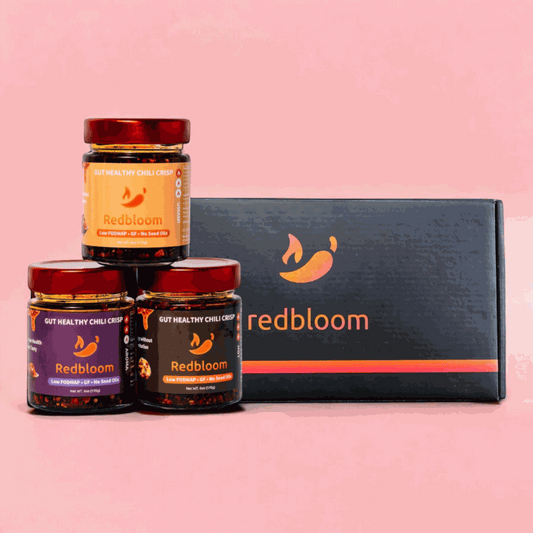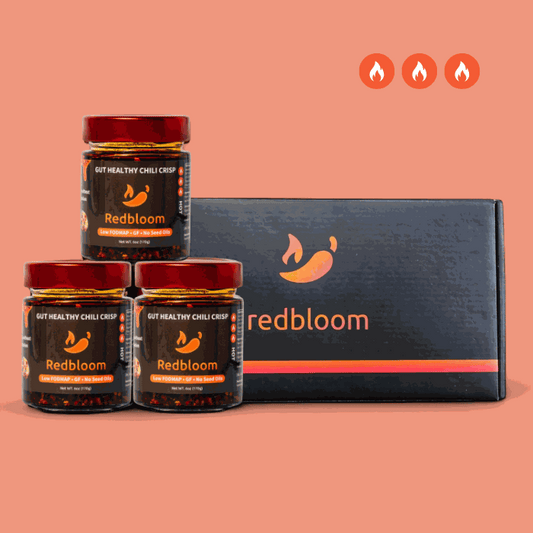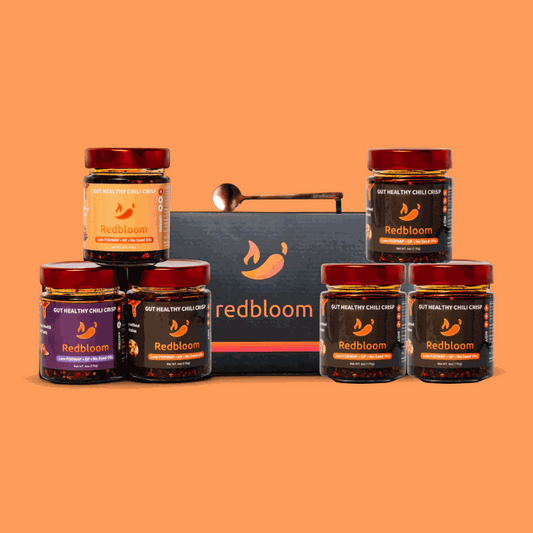Introduction
If you’re someone who loves spicy food but battles IBS, you’ve probably asked yourself: Why does this hurt so bad—and why didn’t anyone warn me? Doctors often suggest vague “bland diet” recommendations, leaving many to navigate a confusing world of flare-ups, triggers, and unexpected reactions. What’s rarely shared is that it’s not just the chili—it’s everything that comes with it.
This guide unpacks the lesser-known truths about spice and IBS—from gender-specific sensitivities and seed oil interactions to desensitization strategies and overlooked ingredients. Whether you’re in flare-up mode or cautiously trying to rebuild spice tolerance, here’s what many wish they’d learned sooner.
1. IBS Reacts Differently in Women
Did you know that women with IBS are disproportionately affected by spicy foods? A study in Iranian adults showed that women who ate spicy foods 10+ times per week were twice as likely to develop IBS compared to those who didn’t, while men showed no significant increase in risk [1].
This suggests that hormonal differences, nervous system variations, or microbiome makeup may heighten sensitivity in women, especially during hormonal shifts like menstruation or perimenopause.
Takeaway: If you’re a woman with IBS, don’t ignore your body’s cues—your sensitivity is biologically real.
2. Capsaicin Can Hurt—or Heal
Capsaicin, the compound that gives chili its heat, plays a paradoxical role in IBS. In the short term, it often triggers burning, urgency, and cramps. But over time, consistent low-dose exposure can reduce sensitivity by desensitizing TRPV1 receptors in the gut and rectum [2].
In one study, patients with IBS-D (diarrhea-predominant IBS) who consumed chili daily for six weeks experienced less abdominal pain and urgency as their bodies adapted [2].
Takeaway: If tolerated, microdosing capsaicin over time may reduce IBS symptoms—but it must be done carefully and slowly.
3. It’s Not Just the Spice—It’s Everything Around It
Spicy foods are often loaded with hidden irritants like:
-
Garlic and onion powder (high-FODMAP)
-
Citric acid and vinegar (acidic triggers)
-
Preservatives like MSG or sodium benzoate
-
Industrial seed oils
All of these can compound gut symptoms like bloating, cramping, and loose stools—even when the chili itself might not be the main problem [4].
Takeaway: Read labels on chili oils, sauces, and crisps. Often, the spice isn’t the only problem.
4. Seed Oils Worsen Inflammation
Many commercial spicy foods are made with cheap seed oils—like soybean, corn, or sunflower oil. These oils are high in omega-6 fatty acids, which, when consumed excessively, can:
-
Promote chronic gut inflammation
-
Fuel dysbiosis (bad bacteria overgrowth)
-
Damage the intestinal lining via oxidized byproducts from refining [5]
In contrast, anti-inflammatory oils like avocado or olive oil may protect gut lining and support healthier digestion [5].
Takeaway: Choose spicy foods made with avocado oil, olive oil, or coconut oil. Ditch the seed oil-based sauces whenever possible.
5. Some People Just Can't Desensitize
Capsaicin works by activating TRPV1 receptors in the gut. But not all bodies respond the same. Genetic variants in these receptors may prevent some people from ever fully desensitizing, which means even small amounts of chili will continue to trigger pain or urgency [2].
Takeaway: If spice always causes symptoms—despite gradual exposure—it might not be your willpower. It could be your genetics.
6. Gut Motility Varies with Spice
Spicy food speeds up or slows down gut movement, depending on the person. Capsaicin may cause diarrhea in one person and constipation in another, complicating how we give or follow advice [6].
Takeaway: Don’t assume there’s a one-size-fits-all reaction to spice. Track your own symptoms to find your unique response.
7. Hidden Triggers in Chili Oil
Love chili crisp? Watch out. Many popular brands include:
-
Garlic/onion powder
-
Sugar or sweeteners
-
MSG or flavor enhancers
-
Citric acid
-
Soybean or canola oil
These ingredients are often gut irritants masked as flavor boosts. Even small amounts can stack up and trigger flare-ups in sensitive guts [4].
Takeaway: If you want to enjoy chili oil, make or buy gut-friendly versions with clean ingredients and low-FODMAP infusions.
8. Gradual Exposure Is Key
If you’re trying to rebuild your spice tolerance, don’t go from 0 to ghost pepper overnight. Use the TRPV1 desensitization method:
-
Start with ⅛ tsp chili oil made from avocado oil
-
Pair it with fat or starch (rice, avocado, coconut)
-
Increase every 3–4 days
-
Watch symptoms like urgency, bloat, or pain
Takeaway: Patience matters. It’s not about avoidance—it’s about smart exposure.
9. Emotional Triggers Make Symptoms Worse
Gut-brain connection is real. Anticipating that chili might hurt can actually amplify gut pain via your nervous system’s heightened alertness.
Takeaway: Eat calmly, chew thoroughly, and practice relaxation during meals. Mindset changes your gut's perception of pain.
FAQs
1. Can I ever eat spicy food again if I have IBS?
Possibly. Many people reintroduce spice successfully through slow exposure, clean ingredients, and gut healing practices.
2. What should I avoid in store-bought chili products?
Watch for garlic, onion, MSG, citric acid, and seed oils. These are common hidden triggers for IBS.
3. Why do seed oils make things worse?
They’re highly inflammatory, promote bad bacteria, and damage gut lining—especially when oxidized during processing.
4. Is capsaicin always bad for IBS?
No. In small, controlled doses, it may help desensitize the gut and reduce symptoms over time.
5. How can I track spice tolerance?
Use a journal. Track dose, food pairings, and symptoms for 6–8 weeks to spot patterns and guide decisions.
Conclusion
If spicy food has ever made you feel betrayed by your body, you’re not alone. But with better understanding comes better control. From hidden triggers to the power of desensitization, there are ways to enjoy spice again—on your terms.
With smarter choices, gut-friendly oils, and a little patience, it’s absolutely possible to keep spice in your life without sacrificing comfort. Start small, stay curious, and remember—you don’t have to give up flavor to protect your gut.





